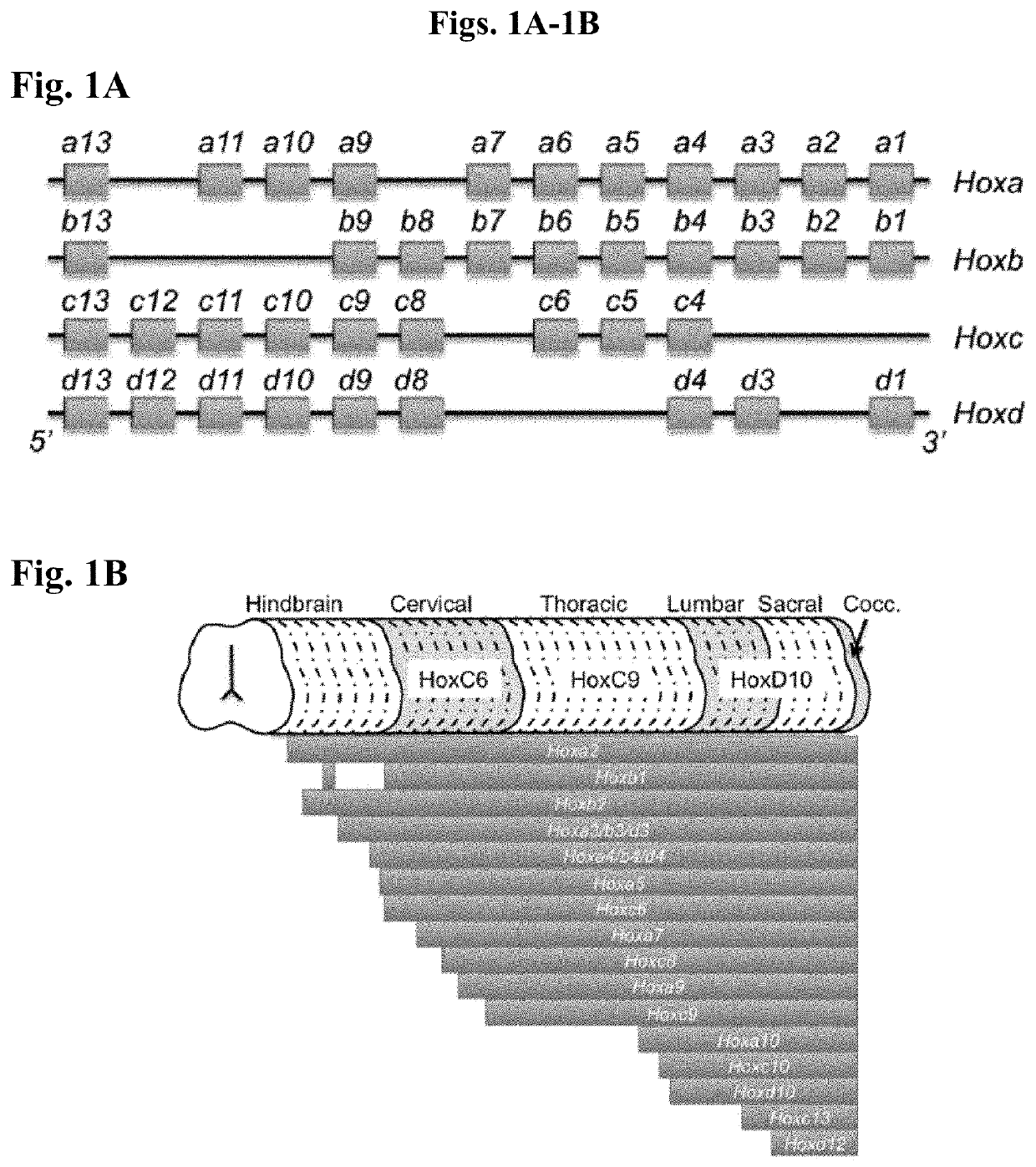Compositions and methods for precise patterning of posterior neuroectoderm from human pluripotent stem cells
a technology of patterning methods, which is applied in the field of composition and methods for precise patterning of posterior neuroectoderm from human pluripotent stem cells, can solve the problems of limited progress in effectively controlling hpsc specification to various segments of the hindbrain and spinal cord
- Summary
- Abstract
- Description
- Claims
- Application Information
AI Technical Summary
Benefits of technology
Problems solved by technology
Method used
Image
Examples
example 1
tion of HOX-Expressing Posterior Caudal Lateral Epiblast from hPSCs
[0140]During formation of the hindbrain and spinal portions of the neural tube, it is currently believed that signaling by FGFs and Wnts maintain an undifferentiated, Sox2+ / Pax6− caudal lateral epiblast stem-like phenotype in the posterior neural tube, whereas retinoic acid (RA) secreted from newly formed somites in the paraxial mesoderm counteracts such signaling to force differentiation to a Sox2+ / Pax6+ neuroectoderm or neuroepithelial state. Moreover, since forebrain explants exposed to FGFs and Wnts can be re-specified to Hox expressing neural tissue, we hypothesized that these morphogens can be used to induce Hox gene expression as hPSCs differentiate into caudal lateral epiblasts. Further, since RA signaling in the neural tube occurs upon regression of the node and concurrent somitogenesis, it can be hypothesized that there is temporal variation in the duration of FGF and Wnt exposure experienced by caudal late...
example 3
on of HOX Gene Expression In Vitro can be Controlled During Differentiation of hPSCs to Caudal Lateral Epiblasts
[0149]In order to determine whether the progression of HOXgene activation is morphogen concentration-dependent, and whether it can be halted at the onset of expression of specific HOXgenes, we performed the same experiment as described in Example 1, but at higher morphogen concentrations followed by multiple culture variations to inhibit the effects of FGF8b and CHIR 99021 (FIG. 3A). After 48 hours of Fgf8b (200 ng / ml) and CHIR 99021 (4 μm) treatment, HOX gene activation in the caudal lateral epiblasts had reached the Hoxc9 locus as opposed to reaching just Hoxc5 under the lower morphogen conditions (FIGS. 2C and 3A), thereby indicating that the rate of Hox gene activation may be morphogen concentration-dependent. Additionally, we demonstrated that removal of Fgf8b and CHIR 99021 and addition of RA is sufficient to halt Hox gene activation, as observed by the lack of Hoxc9...
example 4
REFERENCES FOR EXAMPLE 4
[0177]1. Mallo, M., Wellik, D. M. & Deschamps, J. Hox genes and regional patterning of the vertebrate body plan. Dev Biol 344, 7-15 (2010).[0178]2. Li, X. J. et al. Specification of motoneurons from human embryonic stem cells. Nat Biotechnol 23, 215-221 (2005).[0179]3. Amoroso, M. W. et al. Accelerated high-yield generation of limb-innervating motor neurons from human stem cells. Journal of Neuroscience 33, 574-586 (2013).[0180]4. Lengerke, C. et al. Hematopoietic development from human induced pluripotent stem cells. Ann N Y Acad Sci 1176, 219-227 (2009).[0181]5. Patani, R. et al. Retinoid-independent motor neurogenesis from human embryonic stem cells reveals a medial columnar ground state. Nat Commun 2, 214 (2011).[0182]6. Delfino-Machin, M., Lunn, J. S., Breitkreuz, D. N., Akai, J. & Storey, K. G. Specification and maintenance of the spinal cord stem zone. Development 132, 4273-4283 (2005).[0183]7. Kondoh, H. & Takemoto, T. Axial stem cells deriving both p...
PUM
| Property | Measurement | Unit |
|---|---|---|
| Osmolarity | aaaaa | aaaaa |
| concentration | aaaaa | aaaaa |
| concentration | aaaaa | aaaaa |
Abstract
Description
Claims
Application Information
 Login to View More
Login to View More - R&D
- Intellectual Property
- Life Sciences
- Materials
- Tech Scout
- Unparalleled Data Quality
- Higher Quality Content
- 60% Fewer Hallucinations
Browse by: Latest US Patents, China's latest patents, Technical Efficacy Thesaurus, Application Domain, Technology Topic, Popular Technical Reports.
© 2025 PatSnap. All rights reserved.Legal|Privacy policy|Modern Slavery Act Transparency Statement|Sitemap|About US| Contact US: help@patsnap.com



